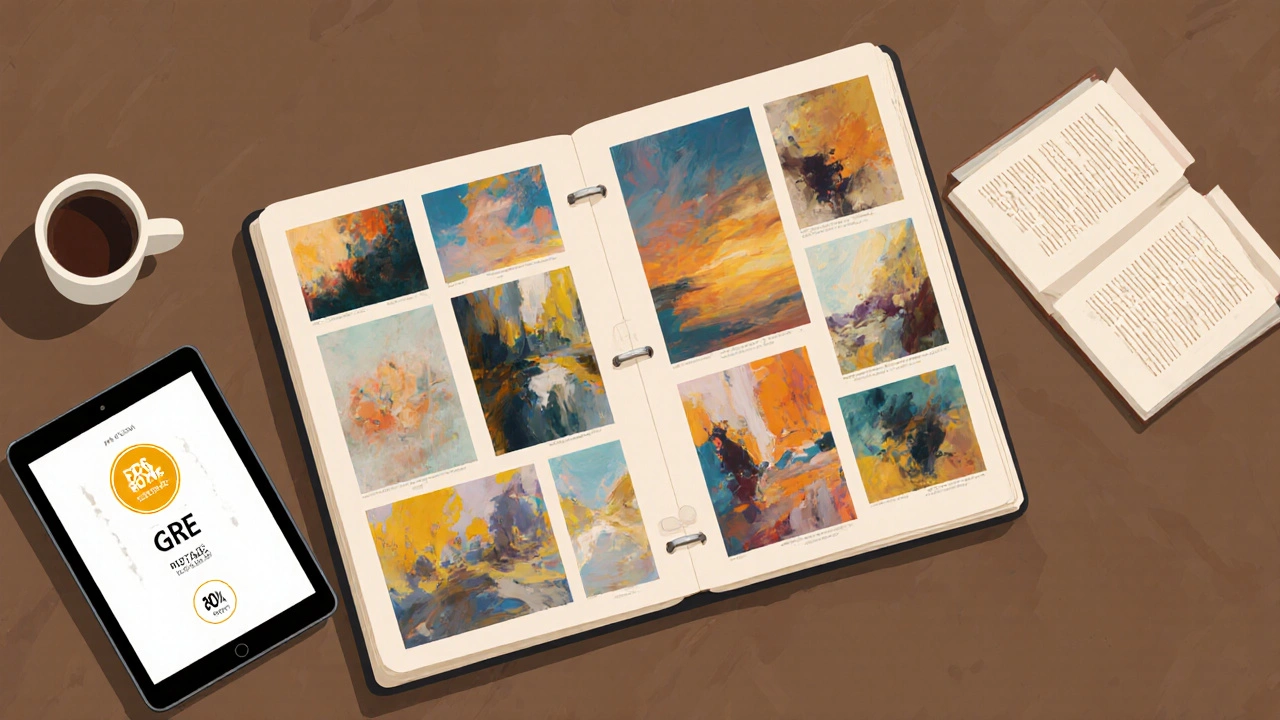Master's Program Admission Strength Calculator
Your Application Strength
Got a 2.5 GPA and still dreaming of a master's program GPA boost? You’re not the first person to wonder if a low GPA can block the door to a master's degree, especially an MFA. The good news: schools look at the whole picture, and there are concrete steps you can take to make your application stand out.
Master's program is a graduate‑level degree that builds on a bachelor’s education and typically requires a higher GPA for admission. An MFA program is a specialized master’s degree focused on visual arts, writing, or performance, often emphasizing a strong portfolio over test scores. Both share a common goal: finding candidates who can succeed academically and contribute creatively.
Why GPA Isn’t the End of the Road
Admissions committees know that a single number can’t capture a student's potential. Many schools publish minimum GPAs-usually around 3.0-but they also list “holistic review” as a catch‑all phrase. That means they weigh other factors such as work experience, artistic achievements, and personal statements. If you can demonstrate growth, passion, and the ability to thrive, a 2.5 GPA becomes just one data point among many.
Know the Numbers: Typical GPA Cutoffs
Understanding the baseline helps you set realistic targets. Here’s a quick snapshot of average minimum GPAs for a handful of well‑known MFA programs (2024‑2025 data):
- Yale School of Art - 3.2 average admitted GPA
- School of the Art Institute of Chicago - 3.0 average admitted GPA
- California Institute of the Arts - 2.9 average admitted GPA
- University of Otago (NZ) - 2.8 average admitted GPA
- Online MFA at Academy of Art University - 2.7 average admitted GPA
These figures show that some programs already admit students below a 3.0. If your target school’s average sits near 3.0, you’ll need to compensate in other areas.
Strengthen Your Application with a Killer Portfolio
For most MFA programs, the portfolio is the kingmaker. A stellar body of work can outweigh a modest GPA in two major ways:
- Showcasing mastery. High‑quality pieces demonstrate technical skill and conceptual depth that grades alone can’t convey.
- Evidence of growth. A clear progression from early student work to professional‑level projects tells committees you’re on an upward trajectory.
Tips for a portfolio that sings:
- Curate 10‑15 pieces that represent your strongest medium and thematic range.
- Include brief captions (title, year, medium) and a one‑page artist statement that ties the works together.
- If possible, get feedback from faculty or established artists before submitting.
- For digital programs, ensure files meet size and format specifications; a broken link can cost you the whole application.

Leverage Standardized Tests and Post‑Baccalaureate Coursework
When your GPA is low, a good GRE or MAT score can act as a safety net. Many MFA schools accept the GRE subject test in art history or the MAT (Miller Analogies Test) as proof of academic readiness. Aim for a score in the 80th percentile to make a noticeable impact.
Another proven tactic is taking post‑bac courses or a “bridge” program. When you earn B+ or higher grades in these classes, you give admissions committees fresh evidence of your academic ability. Look for courses like:
- Advanced Studio Art (college‑level)
- Critical Theory and Visual Culture
- Professional Writing for Artists
Enroll at a local community college or an online platform that offers transferable credits. A 3.5+ average in these courses can offset a 2.5 undergraduate GPA.
Craft a Persuasive Personal Statement
The personal statement is your chance to tell the story behind the numbers. Admissions panels love narratives that explain setbacks and illustrate resilience. Structure your essay like this:
- Hook. Open with a vivid anecdote that sparked your artistic journey.
- Explain the GPA. Briefly acknowledge the low GPA and discuss specific challenges (e.g., working full‑time, health issues, or a major switch).
- Show growth. Highlight what you learned, how you improved your study habits, and any recent academic successes.
- Connect to the program. Mention faculty, resources, or research opportunities that align with your goals.
- Future vision. End with a clear statement of how the MFA will help you contribute to the field.
Keep the tone authentic-don’t over‑polish. Reviewers can sense when you’re trying too hard to sound perfect.
Build Strong Recommendations and Professional Experience
Letters of recommendation can tip the scales. Choose recommenders who can speak to both your artistic talent and your academic potential. Ideal sources include:
- Art professors who supervised a senior project.
- Gallery curators or exhibition managers.
- Employers from creative‑industry positions (e.g., graphic design, copywriting).
Give them a brief packet: your resume, a link to your portfolio, and a note about the GPA issue you’re addressing. The more context they have, the more specific and compelling their letters will be.

Explore Alternative Admission Paths
Many schools offer “conditional” or “provisional” admission routes. Here are three common alternatives that work well for a 2.5 GPA:
| Factor | How to Leverage | Typical Impact |
|---|---|---|
| Portfolio Quality | Curate 12‑15 standout pieces, include an artist statement | High - can outweigh low GPA |
| Standardized Test Scores | Score 80th percentile+ on GRE/MAT | Medium - shows academic readiness |
| Post‑Bac Coursework | Earn B+ or higher in 3‑4 relevant courses | Medium - fresh academic record |
| Professional Experience | Document 2+ years of paid creative work | Medium - demonstrates real‑world skill |
| Letters of Recommendation | Secure 2‑3 detailed, personalized letters | Medium - adds credibility |
Some MFA programs also run “pre‑MFA” summer intensives. Completing one of these shows you can handle graduate‑level workload and gives you a chance to network with faculty.
Action Plan Checklist
Turn the advice into concrete steps. Tick each item off as you go:
- Identify 3‑5 MFA programs that list a holistic review.
- Research each program’s portfolio requirements and deadline.
- Gather 12‑15 best works, write captions, and draft an artist statement.
- Enroll in at least two post‑bac courses; aim for a 3.5+ average.
- Schedule GRE/MAT test; target 80th percentile score.
- Draft a personal statement using the 5‑point structure.
- Ask 2‑3 mentors for recommendation letters; provide them with your portfolio and GPA context.
- Apply to one “conditional admission” program if available.
- Follow up with admissions offices to confirm receipt of materials.
Even if you don’t get in on the first try, you’ll have a stronger academic record and a richer portfolio for the next round.
Frequently Asked Questions
Can a 2.5 GPA be accepted by any top‑ranked MFA schools?
Yes, but it’s rare. Schools like CalArts and the School of the Art Institute of Chicago have admitted students with GPAs under 3.0 when the portfolio was outstanding and supplemental materials (GRE, post‑bac grades) were strong.
Do standardized test scores truly offset a low GPA?
They can. A GRE score in the 80th percentile or higher signals that you can handle graduate‑level coursework. Admissions committees often view strong test results as evidence of academic readiness, especially if recent coursework shows improvement.
What is a “conditional admission” and how does it work?
Conditional admission lets you enroll in a limited set of graduate courses while you improve your academic record. You must maintain a minimum GPA (often 3.0) during that period to become a full‑time MFA student.
How many pieces should I include in my MFA portfolio?
Most programs ask for 10‑15 pieces. Choose works that show a clear conceptual thread, technical skill, and a mix of media if allowed. Quality beats quantity every time.
Should I mention my GPA in the personal statement?
Briefly, yes. Acknowledge the low GPA, explain the circumstances, and focus on what you’ve done since to improve academically and artistically. Keep the tone forward‑looking.
Are online MFA programs less competitive?
Competitive levels vary. Some online programs have lower GPA averages (around 2.7) but still require a strong digital portfolio and professional experience. Research each school’s acceptance statistics before applying.
Bottom line: a 2.5 GPA isn’t a dead end. By bolstering your portfolio, scoring well on tests, taking extra courses, and telling a compelling story, you can turn the odds in your favor. Start planning now, and you might just walk into that MFA studio with confidence.


Comments
Kirk Doherty
Low GPA? Portfolio can carry you.
Dmitriy Fedoseff
When you look at admissions through a cultural lens you see that many schools value the story behind the numbers more than the numbers themselves. A 2.5 GPA is not a death sentence; it is a signal that the applicant has faced challenges that can be turned into artistic fuel. The portfolio, therefore, becomes the philosopher’s stone that transmutes perceived weakness into creative strength. Moreover, standardized tests and post‑bac coursework act as a bridge, demonstrating that the student can meet academic rigor despite past performance. In short, a holistic approach lets you rewrite the narrative and present yourself as a resilient, evolving artist.